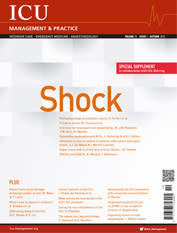Volume 18 - Issue 3, 2018
- ICU
- 16/10/2018
Change content default value
READ MORE
Shock is an emergency, and if it is not treated, it will mostly be fatal. Early intervention and admission to the ICU is essential. Our cover story considers several aspects of shock, including pathophysiology and multi-organ dysfunction syndrome, as well as source control, fluids, differentiation using point-of-care ultrasound and vasoactive medication....
READ MOREOrgan cross-talk is a popular mechanism invoked to explain the progression of multi-organ dysfunction syndrome; however this term is often ill-defined and may encompass many differing mechanisms of organ interaction. In this article the concept of cross-talk is reviewed and its real meaning to the clinical is critically appraised. Multi-organ...
READ MOREPoint-of-care ultrasound (POCUS) is an invaluable tool to differentiate the various types of shock which may co-exist in the critically unwell patient. It is beyond the remit of this article to teach the skill of POCUS. Rather, it provides an overview of how the various POCUS modules could be integrated and utilised in the shocked patient....
READ MOREXenon and brain injury. Xenon, a chemically inert but biologically active monatomic gas, has been applied in patients for anaesthesia/sedation, and most recently in the critical care of patients with acute ongoing neurological damage. Following preclinical evidence that xenon has ameliorative activity in several pathobiologic...
READ MOREDescribes the epidemiology and outcomes for very old patients as known in 2018, along with a short introduction to the most relevant “geriatric syndromes” important also for intensivists, and discusses where we should increase our body of knowledge to make a more precise triage in this patient group. The very old ICU patient is a term often...
READ MOREEvaluation of aids to the delivery of sepsis treatment. In NHS Wales the Sepsis 6 bundle, delivered within one hour of sepsis recognition, has been standard treatment in acute hospital settings since 2013. We describe various methods for increasing the speed and effectiveness of Sepsis 6 bundle delivery that have been trialled with positive...
READ MOREAvicenne ICU’s initiative. Decisions to limit therapy (DTLT) are routine for ICU physicians. Although breaking bad news is one of the most difficult tasks clinicians face, ongoing communication is even more crucial as families (not necessary following a legal or genetic definition) of critically ill patients have heightened communication...
READ MOREShares experiences of implementing extracorporeal life support in a non-academic hospital. Acute respiratory distress syndrome (ARDS) is a life-threatening disorder characterised by severe impairment of gas exchange. The most common causes are pneumonia, sepsis and acute pancreatitis. It is accurately defined in the Berlin definitions...
READ MOREAn individualised goal-directed approach to managing coagulopathy is recommended to treat bleeding trauma patients. Severe trauma is a great burden to society, with millions of victims worldwide. If trauma patients are hazardly bleeding, surgical bleeding requires the surgeon to fix the problem, while coagulopathy requires management...
READ MORE